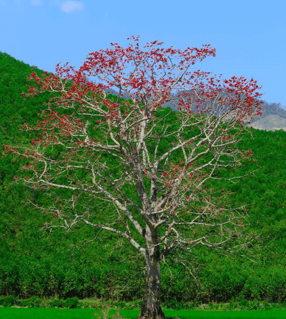Description: The Gạo tree is a large hardwood tree, typically 10–20 meters tall, and can reach up to 30 meters when mature. The trunk is straight, with sharp thorns (when young), and a dense, wide-spreading canopy.'
Leaves: Palmate compound leaves, which usually fall off in winter. Flowers: Bloom around February–April, with brilliant red, five-petaled flowers that grow in clusters at the tips of branches—very prominent when the tree is bare. Fruit: A long capsule containing numerous seeds with white cotton-like fibers.
Key Features:
- A symbolic tree of spring in many Vietnamese rural areas, especially in the North.
- Attracts bees, birds, and many other pollinators.
- Associated with Vietnamese culture, poetry, and memories of the countryside.
Landscape Applications:
- Planted as a public works tree along village roads, in parks, and at schools.
- Creates a focal point due to its striking flower color and beautiful shape.
- Can be used as a shade tree, suitable for tropical climates.
Planting Notes:
- Should be planted in a spacious area because of its deep roots and large trunk.
- Loves sun, is drought-tolerant, and is resistant to pests and diseases.





